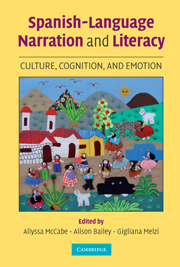Book contents
- Frontmatter
- Contents
- List of Contributors
- Preface
- Acknowledgments
- 1 Introduction
- PART ONE PARENT–CHILD NARRATIVES
- PART TWO DEVELOPING INDEPENDENT NARRATION
- 7 The Intersection of Language and Culture Among Mexican-Heritage Children 3 to 7 Years Old
- 8 Beyond Chronicity: Evaluation and Temporality in Spanish-Speaking Children's Personal Narratives
- 9 Narrative Stance in Venezuelan Children's Stories
- 10 Mestizaje: Afro-Caribbean and Indigenous Costa Rican Children's Narratives and Links with Other Traditions
- PART THREE NARRATIVE LINKS TO LITERACY AND OTHER SCHOOL ACHIEVEMENTS
- Author Index
- Subject Index
- References
7 - The Intersection of Language and Culture Among Mexican-Heritage Children 3 to 7 Years Old
Published online by Cambridge University Press: 05 June 2012
- Frontmatter
- Contents
- List of Contributors
- Preface
- Acknowledgments
- 1 Introduction
- PART ONE PARENT–CHILD NARRATIVES
- PART TWO DEVELOPING INDEPENDENT NARRATION
- 7 The Intersection of Language and Culture Among Mexican-Heritage Children 3 to 7 Years Old
- 8 Beyond Chronicity: Evaluation and Temporality in Spanish-Speaking Children's Personal Narratives
- 9 Narrative Stance in Venezuelan Children's Stories
- 10 Mestizaje: Afro-Caribbean and Indigenous Costa Rican Children's Narratives and Links with Other Traditions
- PART THREE NARRATIVE LINKS TO LITERACY AND OTHER SCHOOL ACHIEVEMENTS
- Author Index
- Subject Index
- References
Summary
Key Words: cultural communities, narrative development, language practices, Mexican, bilingual
ABSTRACT
The primary goal of this chapter is to describe the development of narrative interactions from highly scaffolded to relatively independent narrative productions among a group of low-income Mexican-heritage children growing up in a major city in the southwestern United States. The results from this study simultaneously emphasize the cultural nature of narrative and language development coupled with the evident heterogeneity in cultural practices and developmental trajectories within a particular ethnic and linguistic group. Cultural practices are defined by the language practices enacted and endorsed by families. Variations in children's narrative development are discussed within the context of language practices, providing a platform to highlight the importance of taking a within-culture and longitudinal approach to understanding normative development among minority groups. By looking at patterns of narrative and language development within a cultural context, it is evident that these Mexican-heritage children experience a similar overall developmental trajectory as their European North American (ENA) peers and that there are important variations in narrative structure and adult scaffolding within a group often considered homogeneous. Thinking about cultural language practices appears to be necessary yet not sufficient in our understanding of an individual's development of narrative and language. The chapter ends with a discussion of the implications both for future research and applications with children and families in educational settings.
- Type
- Chapter
- Information
- Spanish-Language Narration and LiteracyCulture, Cognition, and Emotion, pp. 146 - 174Publisher: Cambridge University PressPrint publication year: 2008
References
- 7
- Cited by

